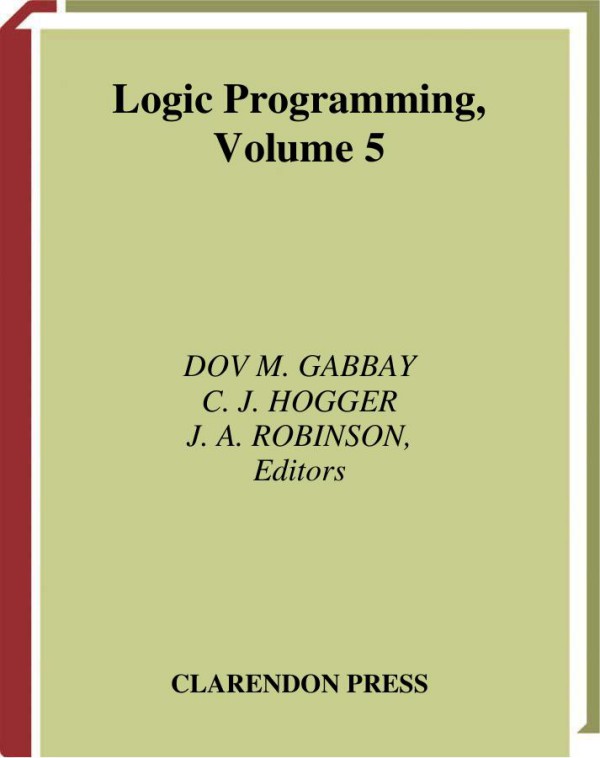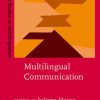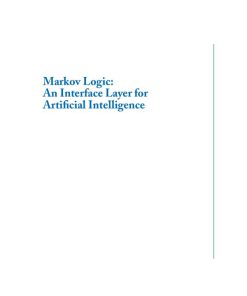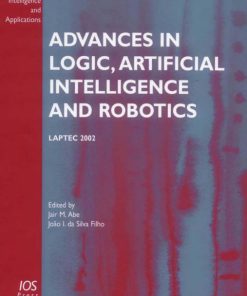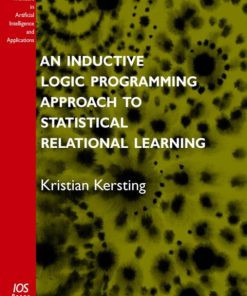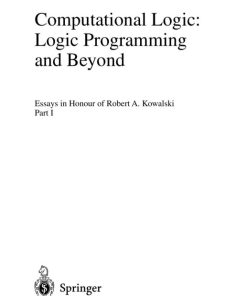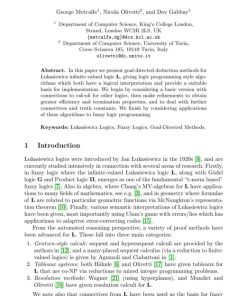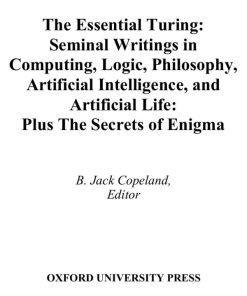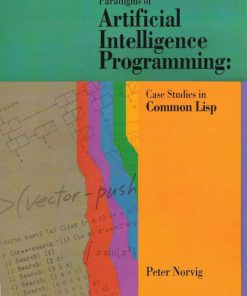Handbook of Logic in Artificial Intelligence Logic Programming Volume 5 ogic Programming 1st Edition by Dov Gabbay, Christopher John Hogger, Robinson 0198537921 9780198537922
$50.00 Original price was: $50.00.$25.00Current price is: $25.00.
Authors:Handbook of Logic in Artificial Intelligence; Logic Programming. Volume 5 Logic Programming-Clarendon Press (1998) , Author sort:Intelligence, Handbook of Logic in Artificial & Press, Logic Programming. Volume 5 Logic Programming-Clarendon
Handbook of Logic in Artificial Intelligence Logic Programming Volume 5 ogic Programming 1st Edition by Dov Gabbay, Christopher John Hogger, Robinson – Ebook PDF Instant Download/Delivery. 0198537921, 9780198537922
Full download Handbook of Logic in Artificial Intelligence Logic Programming Volume 5 ogic Programming 1st Edition after payment
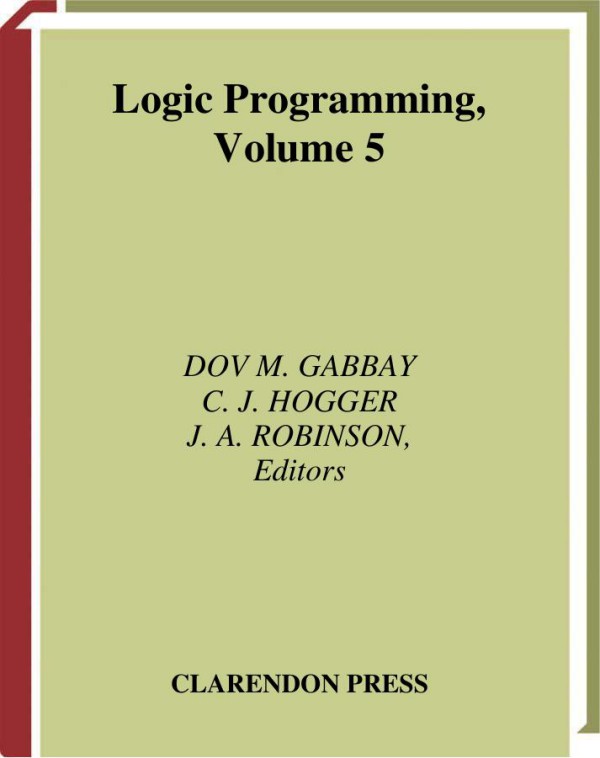
Product details:
ISBN 10: 0198537921
ISBN 13: 9780198537922
Author: Dov Gabbay; Christopher John Hogger; A. Robinson
The Handbook of Logic in Artificial Intelligence and Logic Programming is a multi-volume work covering all major areas of the application of logic to artificial intelligence and logic programming. The authors are chosen on an international basis and are leaders in the fields covered. Volume 5 is the last in this well-regarded series. Logic is now widely recognized as one of the foundational disciplines of computing. It has found applications in virtually all aspects of the subject, from software and hardware engineering to programming languages and artificial intelligence. In response to the growing need for an in-depth survey of these applications the Handbook of Logic in Artificial Intelligence and its companion, the Handbook of Logic in Computer Science have been created. The Handbooks are a combination of authoritative exposition, comprehensive survey, and fundamental research exploring the underlying themes in the various areas. Some mathematical background is assumed, and much of the material will be of interest to logicians and mathematicians. Volume 5 focuses particularly on logic programming. The chapters, which in many cases are of monograph length and scope, emphasize possible unifying themes.
Handbook of Logic in Artificial Intelligence Logic Programming Volume 5 ogic Programming 1st Table of contents:
1 Introduction
1.1 Motivation
1.2 A notational apology
2 Specifying logic programming languages
2.1 Semantic systems and semantic consequences
2.2 Query Systems, questions and answers
2.3 Examples of logic programming languages
3 Implementing logic programming languages
3.1 Proof systems
3.2 Soundness and completeness of proof systems
3.3 Programming systems
3.4 Soundness and completeness of programming systems
3.5 Proof-theoretic foundations for logic programming
4 The uses of semantics
4.1 Logical semantics vs. denotational semantics
4.2 Logical semantics vs. initial/final-algebra and Herbrand semantics
Equational Logic Programming
1 Introduction to equational logic programming
1.1 Survey of prerequisites
1.2 Motivation for programming with equations
1.3 Outline of the chapter
2 Proof systems for equational logic
2.1 Inferential proofs
2.2 Term rewriting proofs
2.3 The confluence property and the completeness of term rewriting
3 Term rewriting proof strategies
3.1 Complete and outer most complete rewriting sequences
3.2 Sequentiality analysis and optimal rewriting
4 Algorithms and data structures to implement equational languages
4.1 Data structures to represent terms
4.2 Pattern-matching and sequencing methods
4.3 Driving procedures for term rewriting
5 Compiling efficient code from equations
6 Parallel implementation
7 Extensions to equational logic programming
7.1 Incremental infinite input and output
7.2 Solving equations
7.3 Indeterminate evaluation in subset logic
7.4 Relational rewriting
Proof Procedures for Logic Programming
1 Building the framework: the resolution procedure
1.1 The resolution procedure
1.2 Linear resolution refinements
2 The logic programming paradigm
2.1 Horn clause logic programming
2.2 A framework for logic programming
2.3 Abstract logic programming languages
3 Extending the logic programming paradigm
3.1 A language for hypothetical reasoning
3.2 Near-Horn Prolog
4 Conclusion
The Role of Abduction in Logic Programming
1 Introduction
1.1 Abduction in logic
1.2 Integrity constraints
1.3 Applications
2 Knowledge assimilation
3 Default reasoning viewed as abduction
4 Negation as failure as abduction
4.1 Logic programs as abductive frameworks
4.2 An abductive proof procedure for LP
4.3 An argumentation-theoretic interpretation
4.4 An argumentation-theoretic interpretation of the abductive proof procedure
5 Abductive logic programming
5.1 Generalized stable model semantics
5.2 An abductive proof procedure for ALP
5.3 An argumentation-theoretic interpretation of the abductive proof procedure for ALP
5.4 Computation of abduction through TMS
5.5 Simulation of abduction
5.6 Abduction through deduction from the completion
5.7 Abduction and constraint logic programming
6 Extended logic programming
6.1 Answer set semantics
6.2 Restoring consistency of answer sets
6.3 Rules and exceptions in LP
6.4 (Extended) Logic Programming without Negation as Failure
6.5 An argumentation-theoretic approach to ELP
6.6 A methodology for default reasoning with explicit negation
6.7 ELP with abduction
7 An abstract argumentation-based framework for default reasoning
8 Abduction and truth maintenance
8.1 Justification-based truth maintenance
8.2 Assumption-based truth maintenance
9 Conclusions and future work
Semantics for Disjunctive and Normal Disjunctive Logic Programs
1 Introduction
2 Positive consequences in logic programs
2.1 Definite logic programming
2.2 Disjunctive logic programming
3 Negation in logic programs
3.1 Negation in definite logic programs
3.2 Negation in disjunctive logic programs
4 Normal or general disjunctive logic programs
4.1 Stratified definite logic programs
4.2 Stratified disjunctive logic programs
4.3 Well-founded and generalized well-founded logic programs
4.4 Generalized disjunctive well-founded semantics
5 Summary
6 Addendum
Negation as Failure, Completion and Stratification
1 Overview/introduction
1.1 Negation as failure, the closed world assumption and the Clark completion
1.2 Incompleteness of NF for comp(P)
1.3 Floundering, an irremovable source of incompleteness
1.4 Cases where SLDNF-resolution is complete for comp(P)
1.5 Semantics for negation via special classes of model
1.6 Semantics for negation using non-classical logics
1.7 Constructive negation: an extension of negation as failure
1.8 Concluding remarks
2 Main body
2.1 Negation in logic programming
2.2 Negation as failure; SLDNF-resolution
2.3 The closed world assumption, CWA(P)
2.4 The Clark completion, comp(P)
2.5 Definite Horn clause programs
2.6 Three-valued logic
2.7 Cases where SLDNF-resolution is complete for comp(P): hierarchical, stratified and call-consiste
2.8 Semantics for negation in terms of special classes of models
2.9 Constructive negation; an extension of negation as failure
2.10 Modal and autoepistemic logic
2.11 Deductive calculi for negation as failure
Meta-Programming in Logic Programming
1 Introduction
1.1 Theoretical foundations
1.2 Applications
1.3 Efficiency improvements
1.4 Preliminaries
2 The non-ground representation
2.1 The representation
2.2 Reflective predicates
2.3 Meta-programming in Prolog
3 The ground representation
3.1 The representation
3.2 Reflective predicates
3.3 The language Gödel and meta-programming
4 Self-applicability
4.1 Separated meta-programming
4.2 Amalgamated meta-programming
4.3 Ambivalent logic
5 Dynamic meta-programming
5.1 Constructing programs
5.2 Updating programs
5.3 The three wise men problem
5.4 Transforming and specializing programs
6 Specialization of meta-programs
6.1 Logic program specialization
6.2 Specialization and compilation
6.3 Self-applicable program specializers
6.4 Applications of meta-program specialization
Higher-Order Logic Programming
1 Introduction
2 A motivation for higher-order features
3 A higher-order logic
3.1 The language
3.2 Equality between terms
3.3 The notion of derivation
3.4 A notion of models
3.5 Predicate variables and the subformula property
4 Higher-order Horn clauses
5 The meaning of computations
5.1 Restriction to positive terms
5.2 Provability and operational semantics
6 Towards a practical realization
6.1 The higher-order unification problem
6.2 Ρ derivations
6.3 Designing an actual interpreter
7 Examples of higher-order programming
7.1 A concrete syntax for programs
7.2 Some simple higher-order programs
7.3 Implementing tactics and tacticals
7.4 A comparison with functional programming
8 Using λ-terms as data structures
8.1 Implementing an interpreter for Horn clauses
8.2 Dealing with functional programs as data
8.3 A limitation of higher-order Horn clauses
9 Hereditary Harrop formulas
9.1 Universal quantifiers and implications in goals
9.2 Recursion over structures with binding
10 Conclusion
Constraint Logic Programming: A Survey
1 Introduction
1.1 Constraint languages
1.2 Logic Programming
1.3 CLP languages
1.4 Synopsis
1.5 Notation and terminology
2 Constraint domains
3 Logical semantics
4 Fixedpoint semantics
5 Top-down execution
6 Soundness and completeness results
7 Bottom-up execution
8 Concurrent constraint logic programming
9 Linguistic extensions
9.1 Shrinking the computation tree
9.2 Complex constraints
9.3 User-defined constraints
9.4 Negation
9.5 Preferred solutions
10 Algorithms for constraint solving
10.1 Incrementality
10.2 Satisfiability (non-incremental)
10.3 Satisfiability (incremental)
10.4 Entailment
10.5 Projection
10.6 Backtracking
11 Inference engine
11.1 Delaying/wakeup of goals and constraints
11.2 Abstract machine
11.3 Parallel implementations
12 Modelling of complex problems
12.1 Analysis and synthesis of analog circuits
12.2 Options trading analysis
12.3 Temporal reasoning
13 Combinatorial search problems
13.1 Cutting stock
13.2 DNA sequencing
13.3 Scheduling
13.4 Chemical hypothetical reasoning
13.5 Propositional solver
14 Further applications
Transformation of Logic Programs
1 Introduction
2 A preliminary example
3 Transformation rules for logic programs
3.1 Syntax of logic programs
3.2 Semantics of logic programs
3.3 Unfold/fold rules
4 Correctness of the transformation rules
4.1 Reversible transformations
4.2 A derived goal replacement rule
4.3 The unfold/fold proof method
4.4 Correctness results for definite programs
4.5 Correctness results for normal programs
5 Strategies for transforming logic programs
5.1 Basic strategies
5.2 Techniques which use basic strategies
5.3 Overview of other techniques
6 Partial evaluation and program specialization
7 Related methodologies for program development
People also search for Handbook of Logic in Artificial Intelligence Logic Programming Volume 5 ogic Programming 1st:
3 rules of artificial intelligence
logic 7.2 answers
4 laws of logic
2.1.2 logic analysis

